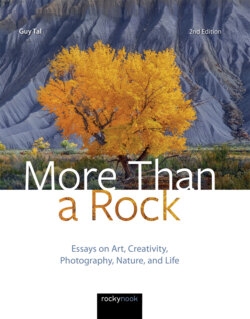Читать книгу More Than a Rock, 2nd Edition - Guy Tal - Страница 16
На сайте Литреса книга снята с продажи.
The Phase of No Emotion7
ОглавлениеBut I did not always know just what it was I wanted to photograph. I believe it is important for a photographer to discover this, for unless he finds what it is that excites him, what it is that calls forth at once an emotional response, he is unlikely to achieve his best work.
—Bill Brandt
After two weeks on the road, I am finally home. There is something about this place that I always love coming back to; something that goes beyond the veneer of the red rocks and the big cottonwood trees, a deeper sense, a feeling of home. The last few days have been among the most beautiful of the year, but I was still in “work mode” and needed to unwind. Today the winds picked up, temperatures dropped a bit, big clouds are moving in, the air is laced with the scent of wood fires, and showers of fallen leaves swirl down from the tall canopies. I realize that “looks like autumn” and “feels like autumn” are two different things. Today feels like autumn.
The same distinction between looks and feels, I find, applies also to images. Some images look like things, while others feel like things; some images are of things, while others are about things. It is a distinction that defies precise definition and that cannot be distilled into simple rules or technique; it can be described but not quite taught, experienced but not spoken, related to but not fully explained. We know it when we feel it; it transcends mere aesthetics and interest, and adds a personal and intimate dimension to mere appearances. The capacity to make such a distinction between what a scene looks like and what it may be made to feel like seems to correlate with a degree of maturity and mindfulness, rather than any technical skill.
In the documentary film Between the Folds, physicist-turned-origami-artist Robert J. Lang speaks of the significant point in his work at which skill and technique began to take a back seat to expressing emotion. Among other things, the transition also resulted in simplification, favoring essence over technical challenge. I can attest to experiencing this effect in my own work, too, and have heard other artists speak of it, as well. What I found most poignant about Lang’s description, however, was his assertion that every artist invariably goes through a “phase of no emotion” as his or her skills and techniques are honed and practiced, and before the resulting work becomes truly expressive of the person behind it. I wonder, however, if this is indeed a period that all artists go through, or rather a phase that only some artists, if they are sufficiently mindful and dedicated, manage to outgrow.
Having just returned from a stretch of photographic workshops, it occurs to me that in a small way, this also serves to articulate one of the greatest challenges of teaching creative pursuits. It is easy to talk about emotion, about the need for introspection, about slowing down, about isolating the creative voice from distractions, and about seeing beyond simple aesthetics. While techniques for accomplishing such things can be discussed in a class, it is nearly impossible to actually implement them in such a setting. In a workshop, whether you are an instructor or a participant, you are often tired and rushed; you are sharing space with people you just met and may not be entirely comfortable with; you are overwhelmed by new subject matter and new knowledge; and you may feel compelled to socialize and entertain—all of which consume precious attention that would otherwise be available for creative work, and may inhibit intimate states of mind needed in order to make emotionally rich images.
Creating significant works is not what attending workshops should be about, nor is it a realistic expectation. Such an expectation is akin to hoping to win a court case after taking an introductory law class, or performing surgery after a short overview of human anatomy. Photography workshops should provide artists not with recipes for finished work but with new and productive ways of thinking about their art; a deeper understanding of certain subjects or techniques; in a setting where such things can be contemplated and practiced free from the demands of everyday life. Unlike such disciplines as law and medicine, however, teaching art also has the added challenge of providing the student with tools to be applied in the expression of personal and subjective notions not available to anyone but themselves. Put another way, there is great value in learning such things in a workshop environment, but even greater value in how students will later apply them in their own work, with their own subjects, and in the expression of their own emotions.
I’m often asked about “one thing” I might suggest to a budding photographer. While I am skeptical that any such simplistic advice can be of real benefit, a suggestion I will make is this: if you recognize yourself as being in a “phase of no emotion,” make a conscious effort to move past it. This has little to do with how technically proficient you are, how many awards you may have won, or any heroic challenges you overcame to “get the shot.” If your work is lacking in emotion, no matter how successful it is by any other measure, consider looking inward. Ask yourself what it is you wish to accomplish and express, and articulate to yourself the what and the why, before considering the how.
All too often photographers look for technical solutions to creative problems only to realize that the answer is not found there. Skills are important, but only insofar as you have something worthwhile to apply them to.
